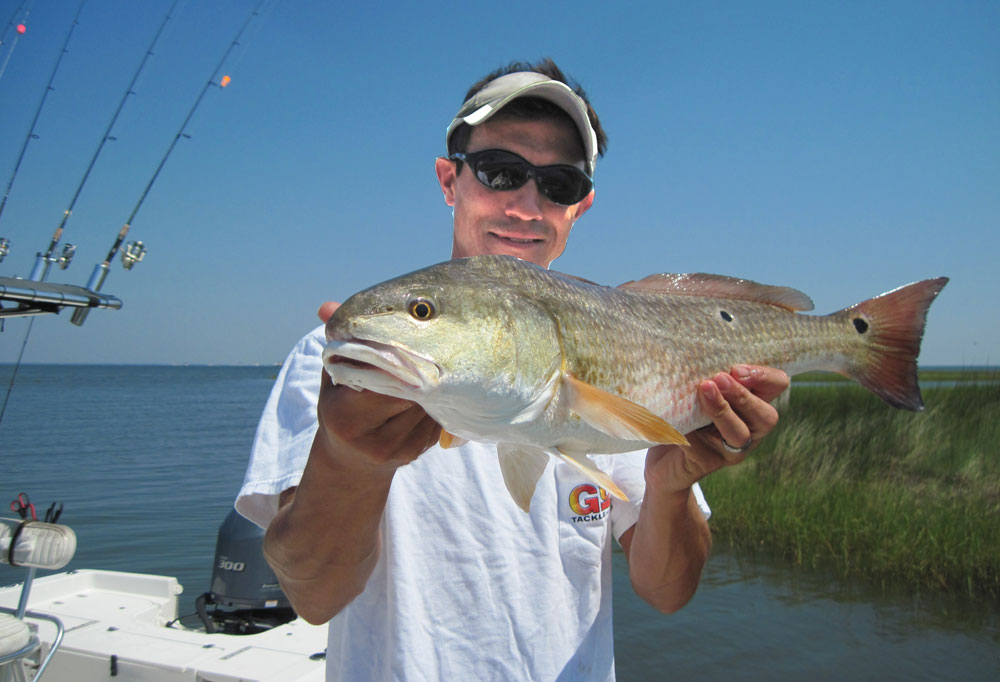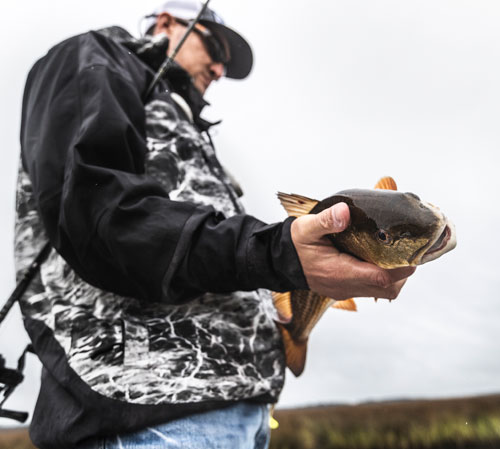
Catching redfish in hot weather – 90-plus degrees - is much like catching speckled trout. You must get out on the water early to locate redfish before 9 a.m. or else fish late in the afternoon.
At this time of the year, my captains and I at Shore Thing Charters, primarily work out of our Cat Island house at Mississippi’s Barrier Islands. Our house there is 7 miles from the mainland, and we ferry our anglers out to Cat Island to sleep, eat and fish. Typically our fleet doesn’t do many afternoon trips, due to the weather being so hot. By fishing from the Cat Island house, we’re only a short boat ride to where we’ll start fishing in the morning. During the heat of the day, we all can sit in the air conditioning, talk about our fishing trips and eat delicious food.
When fishing for redfish, we’re more focused on finding the bait fish to locate the reds. If you’re fishing for speckled trout, you’re focusing on pinpointing the kind of bottom and the water depth where schools of speckled trout will be holding. We’re looking for big school of rain minnows, pogies or mullet for redfish.
We may return to the same spot where we’ve found and caught redfish in the morning but may not find a school of minnows or redfish there in the afternoon, since the minnows and the redfish may move. In the mornings, we either use our big motor to move down the shoreline and search for bait, or our trolling motor when fishing in the marsh. Usually if we find bait, the redfish will be there. When fishing for redfish, we always hunt for the bait first.
 Also we’ll see flounder mixed-in with the reds feeding on the bait, and those flounder are great bonus fish for our customers. At this time of year, the flounder we catch will weigh 2-3 pounds each, just right for an eating-size flounder.
Also we’ll see flounder mixed-in with the reds feeding on the bait, and those flounder are great bonus fish for our customers. At this time of year, the flounder we catch will weigh 2-3 pounds each, just right for an eating-size flounder.
The redfish have been abundant in this summer of 2019, and we’ve caught more reds than I can ever remember catching in any year. The redfish in our section of Mississippi seem to get bigger every year and pull harder. We use several different tactics and baits to catch these reds. I’ve been throwing a cast net lately to catch finger mullet (small mullet from 1-3 inches long), and those mullet have been a very productive live bait for reds. We also take a good number of 4-inch finger mullet with us in the boat, because if we get into a school of redfish too small to keep, we can put on one of the 4-inch mullet on a hook. Then often we’ll catch only the bigger reds that are mixed-in with the smaller, rat-sized reds. Rat reds are far more aggressive than the larger redfish and will eat up your baits quickly.
Once we’ve located a school of bull reds this summer we’ve caught and released some nice ones – up to about 40 inches long. Some of these reds will weigh 30-plus pounds. We tag and release those bull reds. Some people will keep one of the bulls, but for the most part, we just tag, photograph and release those bigger reds.
The slot reds (legal-size reds you can keep) also have been very abundant this year, probably the best year for slot reds ever. Slot reds generally weigh 2-3 pounds. We use a Boat Monkey popping cork that’s loud and heavy enough to enable us to make long casts, even in the wind. We only may use a 1 to 1-1/2 feet of leader, since most of the places we’re catching reds will be extremely shallow. On the end of the leader, we’ll put either a No. 1/0 or a No. 2/0 live bait hook with a small split shot to keep the bait down in the water, since often the bigger live baits will swim up to the surface.
We also fish tight lines without a popping cork and with some soft plastics. Or, we may fish a spinner bait like the Strike King Redfish Magic. We fish a minimum of 20-pound-test braided line and a 40-pound-test-line monofilament leader on our spinning reels. After our customers catch and keep the three redfish they want, we’ll continue to catch, tag and release redfish, as long as the fish are biting. When we tag the redfish, we enter the fisherman’s name and address in our logbook. If the redfish we’ve tagged gets recaptured, we’ll notify our angler what the redfish weighed, and where it was recaptured. The only two fish we tag and release are redfish and tripletails.






























